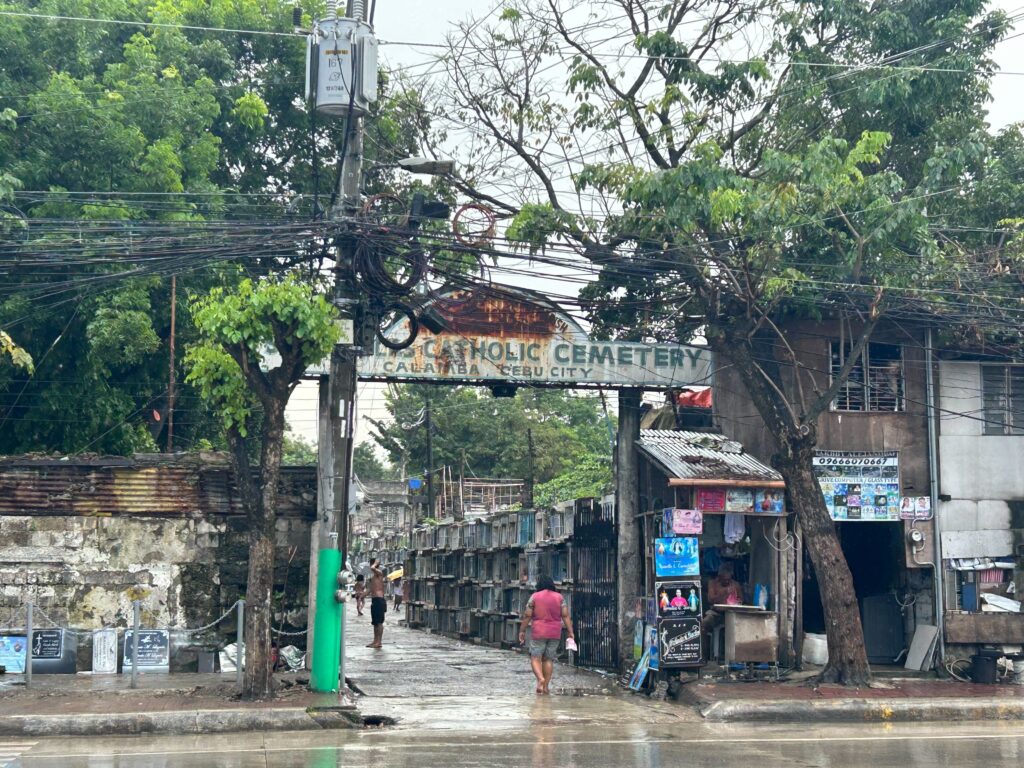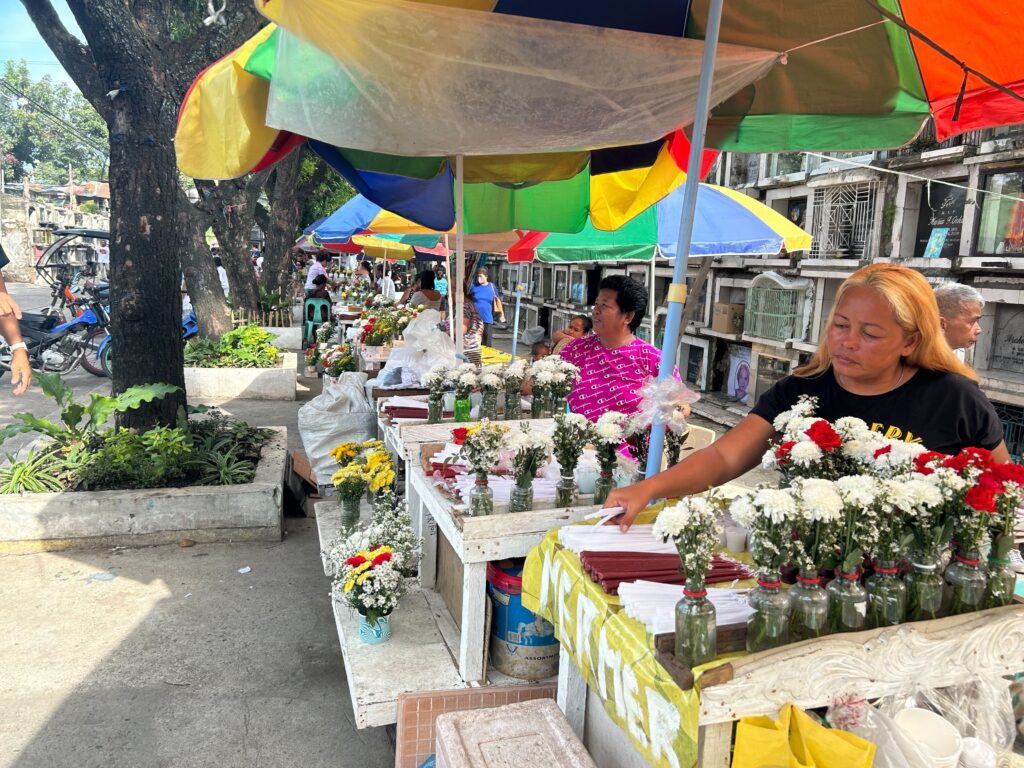
Expect a crowd of people to gather here at the Dakong Krus or the “Big Cross” during the All Soul’s Day or Kalag-Kalag to light candles as an offering to remember their departed loved ones whose bones are placed at a pit near this cross. | Recca Romulo
CEBU CITY, Philippines — As All Soul’s Day or the Kalag-Kalag draws near, people are preparing to visit the tombs of loved ones who have passed on to pray for their souls and to remember them when they were still with us.
Cemeteries are filled as the faithful mark and celebrate this day, a tradition that began in the 10th century to celebrate and pray for souls in purgatory.
On this day, Cebuanos celebrate the day by visiting the graves of their departed loved ones to remember them and pray for their souls.
Here are some things to do and people to meet as you visit cemeteries and remember your loved ones, particularly in one of Cebu City’s biggest cemeteries – Calamba Cemetery.
READ: Sirao flowers now in bloom for Kalag-Kalag visitors

Flower vendors at the Calamba Cemetery have started to set up shop as they expect more visitors at the cemetery as the Kalag-Kalag draws near. | Recca Romulo
Flowers and candles
For Vergie Bagyo, a flower and candle vendor, the day is the peak season for her business, as more people will come to visit the cemetery during Kalag-Kalag, as compared to normal days when the cemetery is usually empty or with only a few people visiting the place.
Bagyo has been in the business for five years and that the prices of candles would vary from P2 for the smallest to P70 for the largest.
She also claimed that she would sell the least expensive flowers at P15 five years ago.
Then the pandemic struck and most vendors, like most people, were affected by this global crisis.
When things returned to normal and people started visiting the cemetery, vendors also got back to business, but by then, the prices had also increased particularly, with the flowers she sold which would now be from P30 for the lowest price one up to P100.
However, she said that her prices would vary slightly from that of other vendors.

Flower vendors at the Calamba Cemetery have started to set up shop on October 28 as they expect more visitors at the cemetery as the Kalag-Kalag draws near. | Recca Romulo
READ: Kalag-Kalag: Beyond candle lighting and Mass offering
Mananabtan
One of the people that one usually encounter at the gates of the cemetery are those who offer their services to pangadye or pray for the souls for you at the tombs or graves of your loved ones.
They are called the mananabtan (prayer leaders) whose service is to lead the prayers for the dead during the Kalag-Kalag — All Souls Day — wakes, death anniversaries, and even during the celebration of the birthday of the departed loved ones.
In times when they are not hired to lead prayers for the dead, some of them frequent the entrance of cemeteries and offer their service to pray the rosary for the dead of people visiting their loved ones at the cemeteries. And they do this for a fee.
Nilda Arnado, a mananabtan or a prayer leader, said that this had been her means of livelihood for the past 18 years.
She said that her earnings from praying for the dead had helped brought food to the table for her family.
She looked back at the pandemic, which had really affected her and other prayer leaders, and as things got back to normal they decided to increase the fee for their services.
There are times when they pray “bug-os,” or nine days’ worth of prayers, in the home of family where a member had passed on. And their are times when families would pay a bit more when they avail of her services to pray during death anniversaries or during the wakes of their loved ones.
READ: Rama plans to restore old, heritage Calamba Cemetery chapel

Candles light up a cemetery as Cebuanos celebrate the Kalag-Kalag or All Souls Day in this file photo. This year in the Calamba Cemetery the families or relatives of their loved ones can have the Pasuga again or have lights at their dearly departed loved ones’ graves be lighted for the duration of the day. | CDN Digital File Photo
Pasuga
Every All Souls Day, some members of the family of their departed loved ones would spend the night in the cemetery. They would even also invite other relatives to spend the night with them in the cemetery where they eat and just talk about the time when the departed loved one was still alive. For some people, this has become a tradition.
As a result, there’s the “pasuga” or have the area where the loved one is buried lighted — where the family members of the departed loved ones would gather for the night.
When asked how much pasuga cost, they replied that it was P350. Antonio Bagyo said that the payment deadline would be on November 1 at 10 p.m.
Bone retrieving, Dakong Krus
During the Kalag-Kalag or All Souls Day or Undas in Tagalog, one can notice hundreds of people offering to light candles at the big cross inside public cemeteries and the Calamba Cemetery is no exception.
The reason for this is that the bones of their loved ones are usually kept in the bone chamber of the cemetery, which is usually a deep pit near the big cross.
Today, this is relevant, because in the cities, the remains of a departed loved one inside tombs or niches would have to be removed so that other bodies would be placed there.
There are no extensions of letting the remains of a loved one stay at the tomb in city’s cemeteries.
The bodies inside the tombs would only be allowed to be placed there for five years.
After that, the bodies would have to be removed and placed in the bone chamber of the cemeteries or the “Dakong Krus” pit.
Antonio Bagyo, chief groundskeeper of the Calamba Cemetery and who has been there for 47 years, described how the remains of the deceased are retrieved.
The deceased must have been buried five years prior. The family and related parties would then be asked by the church if they could relocate the bone to the “Dakong Krus” pit and the bones or remains of the departed loved ones would then be removed from the tomb.

This is the Dakong Krus at the Calamba Cemetery. Expect this area to be filled with people lighting candles there to offer for their departed loved ones. | Recca Romulo
When asked what would happen if the pit became filled, Bagyo said that he could ask the priest to recommend a suitable location for a new “gahong,” which is a very deep pit.
The bone retrieving will cost the families from P300 to P1,000.
He also said that there were cases when they allowed P200 as payment for the retrieving of the bones and these were people who were really poor.
These are just some of the people and the activities that you see inside the cemeteries during the celebration of the Kalag-Kalag.
With the long weekend and with hundreds or even thousands of people expected to visit the cemeteries these November 1 and 2, let us all have a meaningful, safe and happy Kalag-Kalag everyone.
RELATED STORIES
Cebu City committee okays traffic plan for Kalag-Kalag, miting de avance
Undas 2023: Temporary road closures, traffic rerouting near Manila North Cemetery
/dbs
